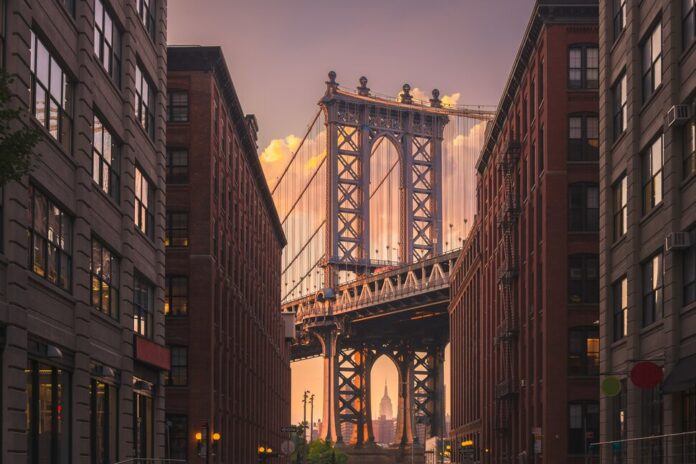Once an independent city and now the most populous of the five boroughs of New York City, Brooklyn boasts enough exciting things to see and do to last a lifetime, let alone a short visit. This epicenter of groundbreaking music, art and cultural centers is overflowing with history and creativity on every block. Immigrants have called Brooklyn home for generations, and the borough remains a multicultural utopia – 1 in 4 Brooklyn residents identify as Jewish, for example. With so much diversity here, Brooklyn has near-endless options for dining, drinking and shopping; its business owners represent nations across the globe. Particularly ingrained in the local culture and a must-try for visitors are Brooklyn’s bagels and pizza, brought over by European immigrants.
Brooklyn contains distinct neighborhoods, tons of public parks and strong environmental programs alongside its flea markets and cozy coffee shops. Visitors to the borough can also find plenty of free things to do, including live concerts, unexpected nights out and distractions for kids such as Coney Island. Though residents may keep relatively tight-lipped about their favorite haunts (lest they become too popular), you’ll find your own “secret” spot in no time. Use this list of top things to do in Brooklyn as a framework for exploration but don’t be afraid to read – and sightsee – between the lines.
(Note: Some of the following activities, attractions and locations may be affected by the COVID-19 pandemic. New policies may be in place, including capacity restrictions, reservation requirements or mask mandates. Check with the Centers for Disease Control and Prevention, the U.S. Department of State and local tourism boards before traveling.)
Coney Island
(Getty Images)
If you start on Manhattan’s Upper East Side and ride the Q train to the end, you’ll arrive in the peninsular neighborhood of Coney Island. This entertainment area is historic, just like the century-old subway line you can take to get there. At the turn of the 20th century, Coney Island saw its heyday as an amusement park destination, dazzling visitors with electric lights, roller coasters and sideshow peculiarities. Following years of economic troubles spurred by the Great Depression, Coney Island is once again an iconic Brooklyn attraction, teeming with eateries and entertainment year-round.
Its annual Mermaid Parade in June is a head-turning event celebrating art and maritime whimsy, while the world-famous hot dog-eating contest – a tradition hosted by Nathan’s that is now more than a century old – takes place each Fourth of July. But most well-known is Luna Park, home of iconic boardwalk arcade games, the fan-favorite Cyclone coaster and the Wonder Wheel, a Ferris wheel so famous there’s even a film of the same name starring Kate Winslet. During the summer months, catch a Brooklyn Cyclones (Minor League Baseball High-A affiliate of the New York Mets) game at Maomonides Park, or in the offseason, check out Coney Island for its ice skating.
Walk the Brooklyn Bridge
(Getty Images)
Putting foot to pavement and traversing the borough’s most famous bridge is a journey for anyone who wants to say they’ve truly seen Brooklyn. The Brooklyn Bridge, built in 1883, connects Brooklyn to Manhattan across the East River and is one of the country’s oldest suspension bridges; its upper level is for pedestrians only. Beginning your jaunt in Brooklyn affords incredible views of Manhattan’s skyline; you can find the Brooklyn Bridge Walkway starting point by heading to the intersection of Tillary Street and Boerum Place downtown.
Join the millions who have completed the crossing, including presidents, celebrities, dignitaries and even 21 elephants (P.T. Barnum used the stunt in 1884 to prove the safety of the bridge). Expect to spend up to an hour heading one direction, with time built in for breaks and photo stops along the walk. The bridge runs about a mile each way, but including pedestrian entrances, it’s more like 1.6 miles. You’ll want to bring plenty of water, wear comfortable walking shoes and know it will be windy with very little sun cover.
Prospect Park
(Getty Images)
Bordering the moneyed Park Slope neighborhood is Prospect Park, Brooklyn’s version of Central Park – it was designed by the architects behind that iconic Manhattan park. Within its more than 500 acres you’ll find the Prospect Park Zoo, a carousel, an ice rink and an open-air band shell that hosts the popular – and often free – Celebrate Brooklyn! summer concert series. Human-made wetlands and a chunk of indigenous forest make a fitting place for the nation’s first urban Audubon Center, which offers environmental educational resources to the public. The Boathouse, built in 1905, is a romantic venue in Prospect Park and one of the first buildings in the city to be declared a historical landmark. The park is dog-friendly, with select off-leash hours and locations, so your four-legged companion can accompany you. Rent a pedal boat, go for a bike ride – visitors can even ride a horse here, so there’s no shortage of things to do in Prospect Park.
Stroll the Brooklyn Heights Promenade
(Getty Images)
Part of Brooklyn’s first Historic Preservation District, the Brooklyn Heights Promenade runs along the East River past some of the borough’s historic town houses and mansions, boasting stunning views of Manhattan. Also known as the Esplanade, this pedestrian walkway is about a third of a mile in length and cantilevered over the Brooklyn-Queens Expressway in the Brooklyn Heights neighborhood. Visitors call it a green oasis with a relaxed atmosphere, and some applaud restrictions on bicycles that make it truly a pedestrian haven. People-watch on a bench or simply view the sun sinking behind lower Manhattan. You can stand where Cher stood in the film “Moonstruck,” or find the plaque along the promenade that supposedly marks where George Washington met with his generals during the 1776 Battle of Brooklyn (also called the Battle of Long Island), the Revolutionary War’s biggest battle. The promenade is one of the many free things to do around Brooklyn.
Bushwick Collective
Museums are fantastic places to find art, but sometimes the best gallery is on the street. The Bushwick Collective is a mecca for street art and graffiti, located in the Bushwick neighborhood of Brooklyn off Flushing Avenue. There are nearly 100 blocks featuring art by local and international artists, so it’s possible to spend a full day here; you’ll find some of the best art on Troutman Street and St. Nicholas Avenue. A pay-what-you-wish tour of the outdoor art space is hosted by Free Tours on Foot. Travelers who explore the Bushwick Collective say it’s a quirky and immersive experience that is well worth the detour. The Bushwick area features plenty of chic bars and restaurants, so stick around after your experience at the Collective to sample its culinary offerings, such as the beloved pizza at Roberta’s.
Domino Park
(Getty Images)
This waterfront park just north of the Williamsburg Bridge gets its name from the Domino Sugar Refinery development it’s located within – the site of a once-operational sugar refinery. The 6-acre green space opened in 2018 and there are nods to its industrial past throughout, including the turquoise shipping cranes that once helped unload the sugar from cargo ships and the elevated Artifact Walk, which runs five city blocks with great views of the Manhattan skyline. A factory-inspired playground offers entertainment for youngsters in the park, and water features will help kids cool down on hot summer days in the city. You’ll also find bocce and volleyball courts, along with a dog run and a gourmet taco stand.
Ride Jane’s Carousel
(Getty Images)
Jane’s Carousel, a wooden structure built in 1922 and originally installed in Ohio, now resides in the Empire Fulton Ferry section of Brooklyn Bridge Park, located in the popular neighborhood of Dumbo (an acronym that stands for Down Under the Manhattan Bridge). The 48 horses and both chariots were carved by the Philadelphia Toboggan Company. Riders note that Jane’s Carousel has been beautifully restored and is a nostalgic way to take a spin with riverfront views. Enjoy this low-cost, antique carousel in its glass pavilion before checking out the rest of what Empire Fulton Ferry has to offer: You can pack a picnic, explore a Civil War-era building that’s now a mall or catch a show at St. Ann’s Warehouse.
Wander the historic neighborhoods of BoCoCa
(Getty Images)
The portmanteau “BoCoCa” never really caught on among New Yorkers, but the area around Boerum Hill, Cobble Hill and Carroll Gardens that the term describes is well worth a visit no matter what you call it. These three tree-lined neighborhoods are an ideal way to spend a morning with a coffee in hand, strolling their enchanting streets and exploring local shops and eateries. Warren Place Mews, a block in Cobble Hill, is an especially historic and unexpected development: Built as affordable housing for local workers in the 19th century, Warren Place now comprises multimillion-dollar homes with Gothic-style architecture. With many less than 12 feet across, these cottages are narrow but highly coveted real estate. They are private property, so respect the privacy of the homeowners, but a peek at this preserved Brooklyn history is worth a trip.
Brooklyn Botanic Garden
(Getty Images)
The massive botanical gardens of Brooklyn have three public entrances and an herbarium with 300,000 specimens of preserved plants for research. The major draw, of course, is the living flora; no matter the season there are always plenty of plants to discover in the gardens. Spring draws crowds when the Brooklyn Botanic Garden’s cherry blossom trees are in bloom, but there is much more to discover year-round, from the sweetly scented Fragrance Garden to the serene Japanese Hill-and-Pond Garden. The grounds also house art collections, conservatories and interactive family-friendly programming. Gardengoers advise putting aside a few hours to explore the spacious grounds, though guided tours may be available with the price of admission on select days.
Each year the Brooklyn Botanic Garden hosts featured exhibitions such as “For the Birds,” a program series that explores the avian connection to plants. Inspired by the birds of Brooklyn, artists created site-specific birdhouses that you can visit around the gardens among other programming.
Carb-load with bagels and pizza
(Getty Images)
New Yorkers take their carbs very seriously – pizza and bagels above all. When in Brooklyn, you’ll likely want to sample both to see what all the fuss is about. Try out Bagel Pub or drop by La Bagel Delight (both shops have various beloved Brooklyn locations) for a fresh and delicious ring of dough. Pizza, meanwhile, is the holy grail of NYC cuisine. If you’re visiting Brooklyn you may consider braving the line outside to snag a table at Grimaldi’s, a chain whose flagship restaurant sits under the Brooklyn Bridge. A true Brooklyn classic since 1939 is L&B Spumoni Gardens, specializing in Sicilian-style pies; its original location is in the Bensonhurst neighborhood. Diners say it might be slightly off the beaten path, but the square slices can’t be beat, and even if the lines look long, they move quickly. For something a bit more modern, go for the namesake slice at Artichoke Basille’s Pizza, with three franchises in Brooklyn (and some at the JFK and LaGuardia airports too, for that last-ditch craving).
The Brooklyn Academy of Music and BAMcafe Live
Home to emerging artists and masters for 150 years and counting, the Brooklyn Academy of Music (BAM) is a multi-arts institution for creators and audiences. The center hosts a variety of events including theater, opera, dance and music performances.
In the spring, BAM hosts an energetic lineup of free live music acts under the moniker “BAMcafe Live.” The series is hosted in the Adam Space, a bar and lounge within the Peter Jay Sharp building, which has been a venue for diverse and emerging artists since 1999. Discover new artists performing genres from jazz and world to R&B, in addition to established performers like TV on the Radio’s Kyp Malone. After a two-year hiatus, the concert series welcomed the 2022 season from February to June.
Look for announcements and updates about upcoming seasons, which run for about five weekends each spring, and sign up for the email newsletter to stay informed about these well-attended shows. Beyond the spring concert series, be on the lookout for indie movie festivals, opera or dance performances and other emergent art.
The Brooklyn Museum
(Jonathan Dorado/Courtesy of Brooklyn Museum)
The Brooklyn Museum features no shortage of variety in its collections and exhibitions. Its displays represent an array of cultures across the globe; the museum’s American offerings include feminist art, African American works that tackle abolitionism and racial identity, and Lenape pieces that center Brooklyn’s Indigenous inhabitants. As one of the largest art museums in the United States, the Brooklyn Museum has five floors filled with myriad types of medium – from textiles and wooden masks to modern photography and found objects. If what’s on display isn’t enough to sate your visual hunger, the permanent Visible Storage installation is perhaps one of the most intriguing features here, as it gives a glimpse into the inner workings of the museum: On the fifth floor, patrons can see about 2,000 “stored” works of American art – a fraction of the thousands in storage – including Tiffany glass and Native American objects.
Museumgoers appreciate both the permanent and special exhibits, saying they’re worth the cost of admission. Tickets are currently on a timed entry and advance purchase is highly recommended. If you plan your visit just right, the museum hosts free evening programming called First Saturdays once each month (but you must register beforehand). If you’re hoping to visit the Brooklyn Museum and the Brooklyn Botanic Garden on your trip, these two attractions offer Museum & Garden combo tickets that grant access to both.
Play shuffleboard at the Royal Palms
(Courtesy of Royal Palms Shuffleboard Club)
Rethink shuffleboard as a game for Floridian retirees and consider it for one of the best nights out in Brooklyn, according to those who have played at The Royal Palms Shuffleboard Club in the Gowanus area. Flanked by cocktails (don’t miss the pina colada) and a rotating lineup of food trucks that might offer Moroccan cuisine or Italian sandwiches, the 10 shuffleboard courts stand at the ready. Pucks and poles – known as “biscuits” and “tangs” in the lingo – are rented out by the hour, and players recommend only starting once you have your drinks in hand as the time goes quickly. The 17,000-square-foot game hall accommodates shuffle regulars and newbies alike, with a staff on hand to give tips as needed. The shuffleboard court welcomes anyone 21 and older on a walk-in basis; reservations are not required.
Green-Wood Cemetery
(Getty Images)
Cemeteries are peaceful places full of history; from France to New Orleans, living visitors walk among the dead as a pastime. Green-Wood Cemetery, adjacent to the Greenwood Heights neighborhood in Brooklyn, has served as a tourist attraction since the mid-1800s. Today the cemetery welcomes respectful visitors to its nearly 500 acres, which apart from graves also feature art installations (even an artist in residence), an arboretum and opportunities for birding in the middle of the city. Founded in 1838 as one of the country’s first rural cemeteries, Green-Wood is now the final resting place of more than half a million individuals.
Download a map for a self-guided walk, or use an app intended to help visitors explore the art, nature and history of Green-Wood. You may be able locate the graves of some of the more famous permanent residents here, such as Jean-Michel Basquiat, Louis Comfort Tiffany and Leonard Bernstein. Tours of Green-Wood Cemetery aren’t limited to walking; informative trolley tours cover a lot of ground and can be booked with expert guides who are on hand to answer all of your questions.
Industry City
(Courtesy of Industry City)
A makers’ paradise has taken shape at Brooklyn’s Sunset Park near the Barclays Center. Industry City, a massive complex spread across 16 buildings and plenty of green space, houses a community of collaborators in its studio space, office space and kitchens – walk-ins certainly reap the rewards. A visit to Industry City can provide groceries, artisanal drinks and plates, and some of the most authentic souvenirs you’ll find throughout the boroughs. There’s even a Morbid Anatomy Library and Gift Shop with hundreds of unique books and artifacts.
A couple dozen culinary vendors specialize in everything from avocados to Korean comfort food and a Mediterranean grocer. Beverages are equally exalted with a courtyard devoted to brewing and distilling, which includes New York’s first sake brewery. Shopping takes you across the globe to examine fine Moroccan textiles or Japanese toys. The Makers Guild means you might be able to meet the maker behind the item you’re purchasing, from soaps to shirts. Those who have wandered in remark that it’s a one-stop destination to spend a fun night with friends or the family.
New York Transit Museum
Housed in a former subway station, the New York Transit Museum sits about a mile from Fort Greene Park. Recent patrons call it a must for anyone interested in the history of New York’s subways and labyrinthine transportation system. As the largest museum in the country devoted to urban public transportation history, the museum includes artifacts like restored former train cars and photographs from the inception of the city’s rail system. If you’re visiting in the summer, the seasonal “Nostalgia Rides” give the public access to the trains New Yorkers rode on a century ago. Be on the lookout for other events and programming that may coincide with your museum visit. The museum is located down two flights of stairs, but an accessible entrance is located at the corner of Schermerhorn and Court streets.
House of Yes
The House of Yes has been open for several years in its current iteration and has firmly established its place on the scene as one of Brooklyn’s top nightclubs and performance spaces for New York’s underground arts community. The House of Yes was born in Brooklyn in 2007 as a creative live-work space; followers may find pop-ups throughout the country – or even in London – but its home base is still in Brooklyn. The venue today is situated in the Bushwick neighborhood. Check out burlesque-style shows, themed dance parties, drag competitions and more on the club’s events calendar. The House of Yes is an inclusive space that features LGBTQ artists and dancers and regularly hosts queer nights. Clubgoers say the space is eclectic and ideal for those looking to put their inhibitions aside – but be prepared for pricy drinks and even pricier bottle service.
Brooklyn Children’s Museum
(Winston Williams/Courtesy of Brooklyn Children’s Museum)
Much of Brooklyn may feel like it’s designed for young adults and an older crowd, but there are spaces in the city dedicated to children, and one of the best is the Brooklyn Children’s Museum. Sensory stimulation and tactile play are all part of the experience here. Littles can play and climb on a rooftop structure called The NEST (made from local reclaimed water tower cedar), or play make-believe at pint-sized versions of real businesses called World Brooklyn. The ColorLab studio lets artists of all ages explore their creativity through workshops on print-making, collage, sculpture and more; its programming is inspired by Black artists, with a different muse chosen each month. Recent visitors appreciate the diversity on display in this museum and note that it’s geared toward younger kids. The museum recommends purchasing tickets in advance, particularly since it’s a cashless facility.
Rummage through the Brooklyn Flea
(Courtesy of Brooklyn Flea)
New York City has some of the best thrift shops and record shops in the world. Go on your own treasure hunt at the Brooklyn Flea, held on weekends between April and December at Pearl Plaza in Dumbo. More than 40 vendors sell everything from tchotchkes to period furniture to the aforementioned records and vintage clothes. Since rummaging works up an appetite, this flea market began an affiliated food market called Smorgasburg, which features the best of Brooklyn’s food scene with about 100 vendors; find it Saturdays in Williamsburg and Sundays in Prospect Park’s Breeze Hill from April through October.
Another player in Brooklyn’s long history of upcycling is Big Reuse, a facility that sells, repurposes and even composts. Its store, located on 12th Street in Gowanus (about 3 miles south of the Brooklyn Flea), offers true hidden gems that could include signed artwork, collectibles and antique furniture at a bargain.
Take a hip-hop bus tour
Brooklyn’s in the house – and it would be nearly impossible to appreciate the borough fully without acknowledging its role in hip-hop history. Brooklyn has produced the likes of Jay-Z, the Notorious B.I.G., Mos Def, Talib Kweli, Lil’ Kim – the list goes on. Hush Tours offers cultural hip-hop tours of Brooklyn as well as Harlem and Queens. Take a bus tour or walking tour of Brooklyn with some of the local legends who have contributed to the genre from this state-certified Minority and/or Women-owned Business Enterprise. Reviews rave about the passionate, energetic and engaging tour guides, saying you don’t have to be a fan of rap music to appreciate hip-hop culture and the place that helped shape it. See the murals, landmarks and venues that have influenced generations of hip-hop artists; you might even land on Biggie Smalls’ former doorstep.
Witness the lights of Dyker Heights
(Getty Images)
Everyone has their favorite season in New York – and you should really experience them all – but East Coast winter blues are expelled annually by citywide holiday cheer. In Brooklyn, that cheer is concentrated into the blinding beacon of the Dyker Heights Christmas Lights. Amid the rich diversity in this borough you’ll find holiday displays ranging from a house lit up in blue for Hanukkah to one that spells out “Merry Christmas” in Greek. What started in the 1980s as a friendly competition among neighbors has become a tradition for many families – the ones who decorate and the ones who simply visit. Decorating budgets grow with each year, with some professional installations estimated to cost $20,000 or more. Some websites have organized maps of each year’s must-see lights displays; repeat visitors advise keeping to 11th through 13th avenues (also called Dyker Heights Boulevard) between 83rd and 86th streets. Out-of-towners say it’s one of the most festive displays they’ve ever seen. Wait until mid-December to get the most out of your stroll, and be sure to go before 9 p.m. when some homeowners head to bed and unplug to save on their electric bills. Take care, though, not to trespass on any private property or disrupt the displays.










